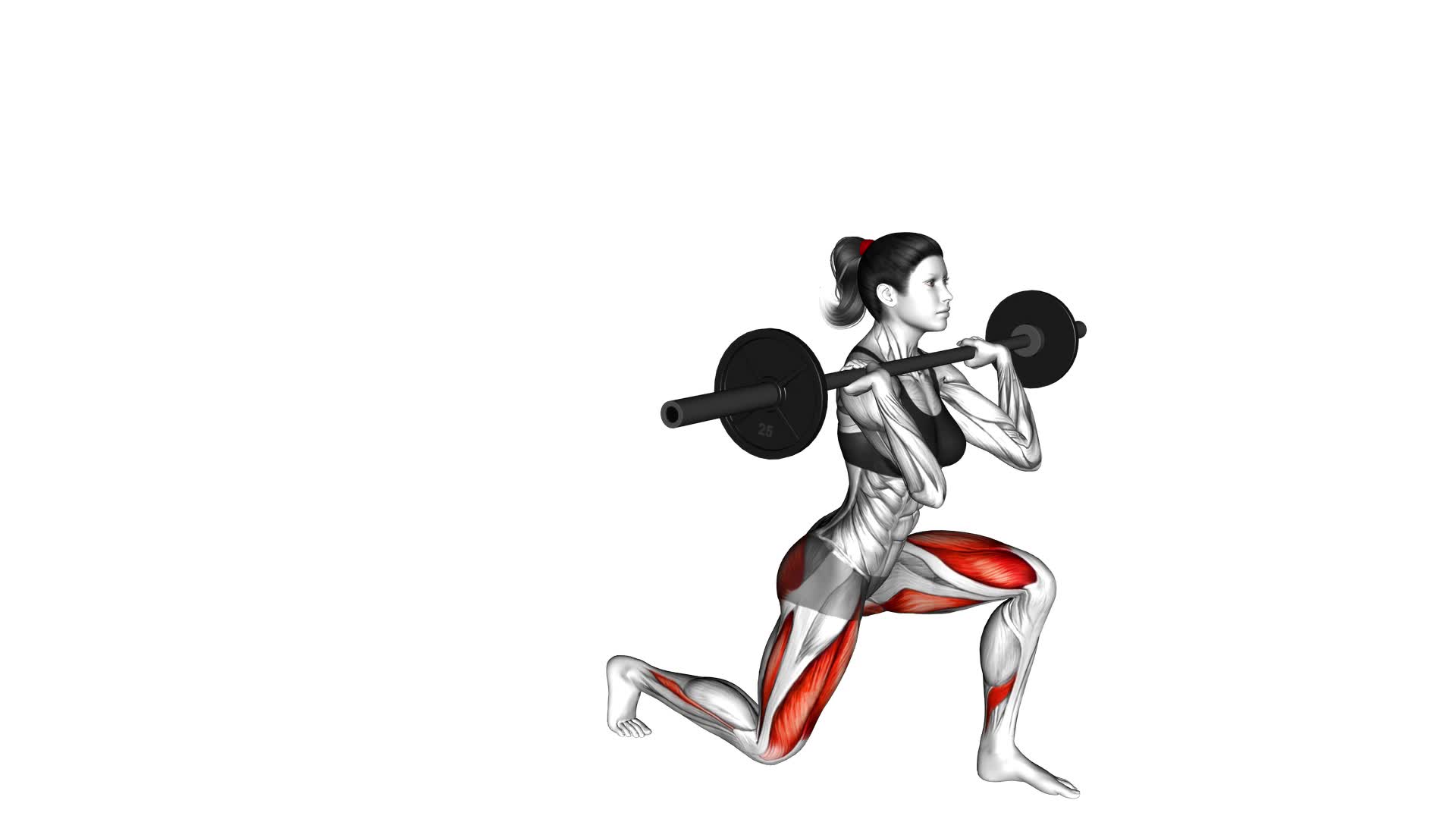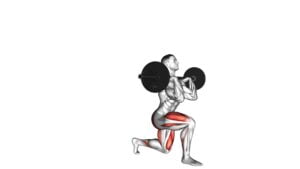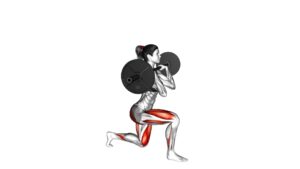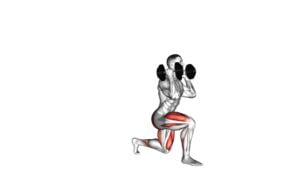Barbell Front Rack Lunge (female) – Video Exercise Guide & Tips

Looking to level up your leg workout?
Watch This Exercise Video
The barbell front rack lunge is a killer exercise that targets your quads, glutes, and core all in one go.
In this video exercise guide, we'll show you proper form and technique, along with tips to maximize your results.
Whether you're a beginner or advanced, this exercise will challenge and sculpt your lower body.
So grab a barbell and get ready to lunge your way to stronger, leaner legs.
Let's do this!
Key Takeaways
- Targets quads, glutes, and core muscles simultaneously
- Increases stability and improves balance
- Activates major muscle groups like quadriceps, hamstrings, glutes, and calves
- Enhances muscle development and efficiency in lower body workouts
Benefits of the Barbell Front Rack Lunge
Discover the numerous benefits of incorporating the Barbell Front Rack Lunge into your workout routine. This exercise is highly effective in increasing stability and activating multiple muscle groups simultaneously.
The Barbell Front Rack Lunge enhances stability by challenging your core muscles and improving your balance. By holding the barbell in front of your body, your core muscles are engaged to maintain an upright posture throughout the movement. This increased stability not only helps you during the lunge but also carries over to other exercises and daily activities.
In addition to stability, the Barbell Front Rack Lunge activates several major muscle groups. The quadriceps, hamstrings, glutes, and calves are all targeted during this exercise. By performing lunges with a barbell in the front rack position, you place a greater emphasis on the quadriceps and glutes compared to other lunge variations. This leads to greater muscle activation and development in these areas.
To maximize the benefits of the Barbell Front Rack Lunge, it's important to maintain proper form and control throughout the exercise. Keep your chest up, shoulders back, and step forward with a controlled movement. Ensure that your knee stays aligned with your ankle, and avoid letting it collapse inward.
Incorporating the Barbell Front Rack Lunge into your workout routine won't only improve your stability but also activate multiple muscle groups for a more efficient and effective workout.
Proper Set-Up and Equipment for the Exercise
To properly set up and perform the Barbell Front Rack Lunge, you'll need a barbell and a rack. The barbell should be loaded with the appropriate weight for your fitness level and goals. It's recommended to start with a weight that challenges you but still allows you to maintain proper form throughout the exercise. As you become more comfortable and stronger, you can gradually increase the weight.
There are a few set up variations you can consider when performing the Barbell Front Rack Lunge. First, adjust the height of the rack so that the barbell is at shoulder level. This will make it easier to unrack and rack the barbell. Secondly, position yourself in front of the rack with your feet shoulder-width apart and your toes pointing forward. Place the barbell across your upper chest, resting it on your front delts and collarbone.
Make sure to maintain a strong and stable core throughout the exercise. Keep your chest lifted, shoulders back, and engage your glutes and quads as you lunge forward. Remember to keep your front knee aligned with your ankle and avoid letting it go past your toes. Control your movement as you step back to the starting position and repeat on the other leg.
Step-by-Step Guide to Performing the Barbell Front Rack Lunge
To perform the Barbell Front Rack Lunge, you'll need to follow these step-by-step instructions.
Start by placing a barbell on your shoulders in a front rack position, with your elbows up and your hands gripping the bar.
Take a step forward with one leg, lowering your body until your front knee is bent at a 90-degree angle and your back knee is just above the ground.
Make sure to keep your torso upright and your core engaged throughout the movement.
Push through your front heel to stand back up and return to the starting position.
Repeat on the other leg to complete one rep.
If you're looking for some barbell lunge variations, you can try the Barbell Reverse Lunge or the Barbell Walking Lunge.
The Reverse Lunge involves stepping back with one leg instead of stepping forward, while the Walking Lunge involves taking continuous steps forward with each lunge.
These variations can help target different muscles and add variety to your workout.
Now that you know how to perform the Barbell Front Rack Lunge, let's move on to the next section where we'll discuss common mistakes to avoid during the exercise.
Common Mistakes to Avoid During the Exercise
One common mistake to avoid during the Barbell Front Rack Lunge is allowing your knees to collapse inward. This can put unnecessary stress on your knee joints and increase the risk of injury. To prevent this mistake and maintain proper form, follow these tips:
- Keep your knees in line with your toes: As you lower into the lunge, make sure your knees are tracking in the same direction as your toes. This helps to maintain stability and proper alignment.
- Engage your core: A strong core provides stability and support during the exercise. Keep your abdominal muscles tight throughout the movement to help prevent your knees from collapsing inward.
- Focus on hip stability: Weak hip muscles can contribute to knee collapse. Strengthen your hips with exercises like clamshells and lateral band walks to improve stability and prevent form errors.
- Start with lighter weight: If you're struggling to maintain proper form, it may be a sign that the weight you're using is too heavy. Begin with lighter weights and gradually increase as you build strength and improve your technique.
Tips to Increase the Intensity and Effectiveness of the Barbell Front Rack Lunge
To increase the intensity and effectiveness of the Barbell Front Rack Lunge, focus on incorporating dynamic movements and challenging variations.
One way to increase resistance is by gradually adding more weight to the barbell. Start with a weight that challenges you but still allows for proper form and gradually increase it as you get stronger.
Another variation to try is the Barbell Front Rack Walking Lunge. Instead of performing the lunge in place, take steps forward, alternating legs with each step. This will engage your core and challenge your balance even more.
Additionally, you can try the Barbell Front Rack Reverse Lunge. Instead of stepping forward, step backward with one leg while keeping the other leg stationary. This variation targets your glutes and hamstrings more intensely.
Lastly, you can also incorporate plyometric movements such as the Barbell Front Rack Jump Lunge. Start in a lunge position and explosively jump, switching legs mid-air and landing softly back into a lunge. This won't only increase the intensity but also improve your power and explosiveness.
Remember to always prioritize proper form and gradually progress to more challenging variations.
Frequently Asked Questions
How Many Repetitions Should I Perform When Doing the Barbell Front Rack Lunge?
When performing the barbell front rack lunge, it's important to consider your fitness level and goals. Start with a weight that challenges you, but allows you to maintain proper form. Aim for 8-12 repetitions per set, gradually increasing the weight as you get stronger.
Remember to listen to your body and modify the exercise if needed. Variations include using dumbbells or kettlebells instead of a barbell, or performing reverse lunges instead of forward lunges.
Can I Substitute the Barbell With Dumbbells or Kettlebells for This Exercise?
Yes, you can definitely substitute the barbell with dumbbells or kettlebells for the front rack lunge.
By using dumbbells, you can perform dumbbell front rack lunges, which will target the same muscles and provide a similar challenge.
Kettlebells can also be used for kettlebell front rack lunges, adding an extra stability and grip challenge.
Both variations are effective alternatives to the barbell front rack lunge and can help you achieve your fitness goals.
Is It Necessary to Warm up Before Performing the Barbell Front Rack Lunge?
It's important to warm up before performing the barbell front rack lunge. Warming up helps increase blood flow to your muscles, preparing them for the exercise. This can reduce the risk of injury and improve your performance.
To warm up, you can do some light cardio, dynamic stretches, or bodyweight exercises.
As for the correct form and technique for the barbell front rack lunge, make sure to keep your core engaged, chest lifted, and step forward with control, maintaining a 90-degree angle in your front knee.
Can the Barbell Front Rack Lunge Help Improve My Balance and Stability?
To improve your balance and enhance stability, the barbell front rack lunge can be a great exercise. By placing the barbell on the front of your shoulders, you challenge your core muscles to maintain balance.
As you lunge forward, your legs work to stabilize your body. This exercise targets multiple muscle groups, including your quadriceps, hamstrings, glutes, and core.
Incorporating the barbell front rack lunge into your workout routine can help you develop better balance and stability overall.
Are There Any Modifications or Variations of the Barbell Front Rack Lunge That I Can Try?
To add variety and challenge to your workout, there are a few modifications and variations you can try with the barbell front rack lunge.
One option is to perform the lunge with dumbbells instead of a barbell, which can help improve your grip strength.
Another variation is the walking lunge, where you take steps forward while lunging.
These variations not only target different muscles but also enhance your coordination and balance.
Conclusion
In conclusion, the barbell front rack lunge is a highly effective exercise that targets multiple muscle groups and improves lower body strength and stability. By following the proper set-up and technique, avoiding common mistakes, and incorporating tips to increase intensity, you can maximize the effectiveness of this exercise.
Remember to always consult with a fitness professional before starting any new exercise program to ensure proper form and technique. Keep pushing yourself and enjoy the benefits of the barbell front rack lunge!

Author
Years ago, the spark of my life’s passion ignited in my mind the moment I stepped into the local gym for the first time. The inaugural bead of perspiration, the initial endeavor, the very first surge of endorphins, and a sense of pride that washed over me post-workout marked the beginning of my deep-seated interest in strength sports, fitness, and sports nutrition. This very curiosity blossomed rapidly into a profound fascination, propelling me to earn a Master’s degree in Physical Education from the Academy of Physical Education in Krakow, followed by a Sports Manager diploma from the Jagiellonian University. My journey of growth led me to gain more specialized qualifications, such as being a certified personal trainer with a focus on sports dietetics, a lifeguard, and an instructor for wellness and corrective gymnastics. Theoretical knowledge paired seamlessly with practical experience, reinforcing my belief that the transformation of individuals under my guidance was also a reflection of my personal growth. This belief holds true even today. Each day, I strive to push the boundaries and explore new realms. These realms gently elevate me to greater heights. The unique combination of passion for my field and the continuous quest for growth fuels my drive to break new ground.







